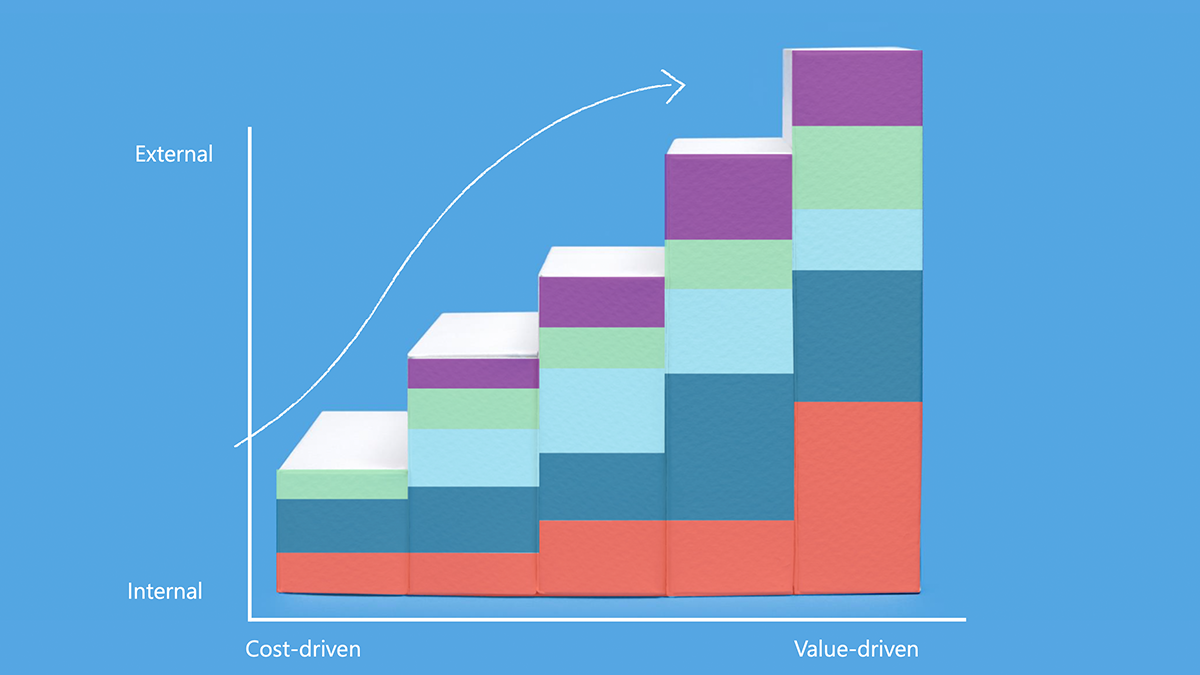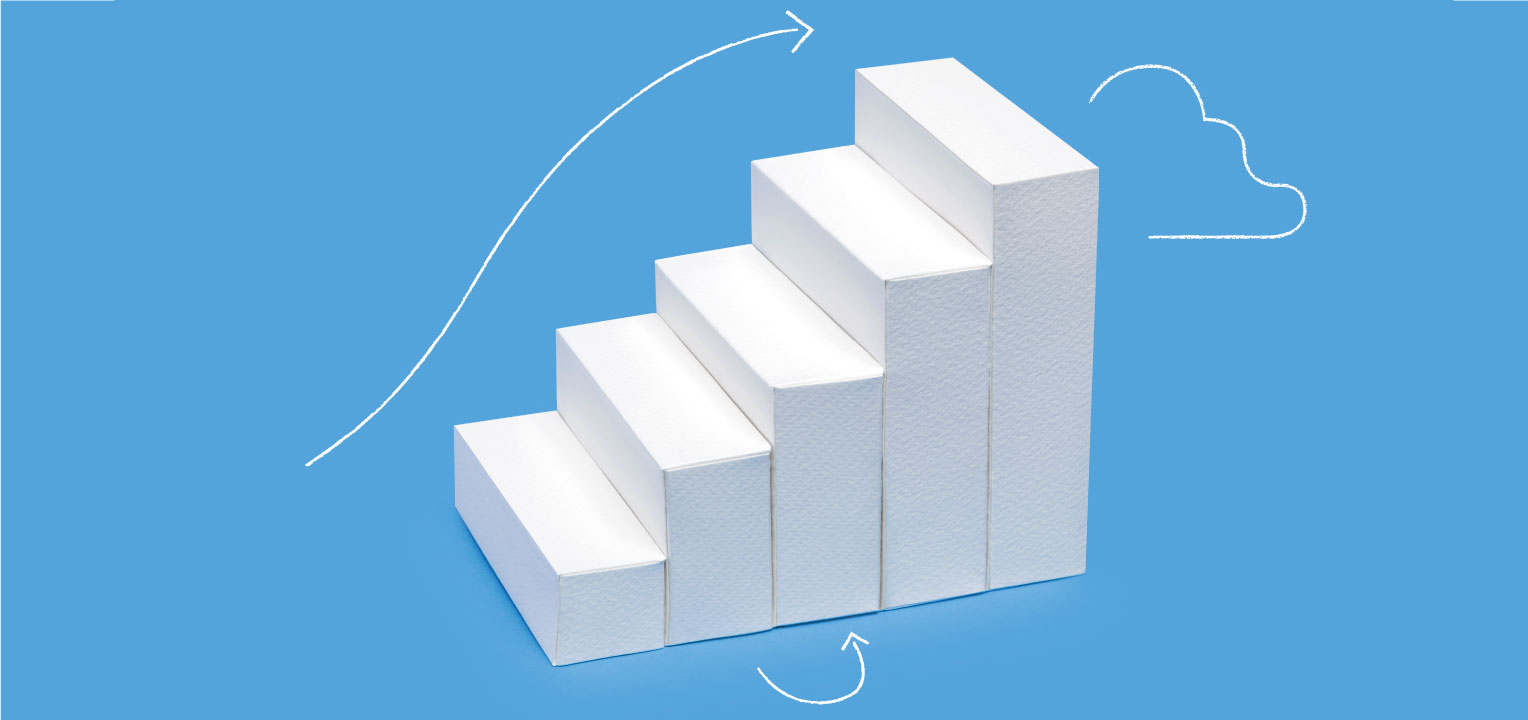Where does your organization stand in terms of its service delivery? Are the service departments in your organization healthy, or do they lack direction? And how can they maximize their value for their customers? The TOPdesk Service Excellence Maturity Model answers these questions. Use the model to find out how mature the various departments in your organization are and to gain key insights into which service management areas need improving.
The Service Excellence Maturity Model
The model has two axes: the internal or external business focus of service departments, and the cost-driven or value-driven mindset of service departments.
The vertical axis deals with the business focus of service departments. If a department is internally focused, it tends to focus on optimizing its own processes. The main emphasis is on finding technological developments that support its own activities. A department with an external focus is more customer-driven: its perspective revolves more around the organization as a whole. New technologies and improvements are mainly aligned with the needs of the entire organization.
The horizontal axis deals with the mindset of service departments. Is the department isolated, and does it mainly focus on managing costs? Or does it focus on adding continuous business value? The more departments focus on creating value for the organization rather than on their own processes and goals, the less prone they are to disruption of any kind. Introducing certain service tactics and technologies will allow service organizations to change their focus to successfully deliver more value to the business, its employees, and its customers, ultimately reaching a higher level of maturity.

The five maturity levels
The Service Excellence Maturity Model has five maturity levels. Once a service department reaches a certain maturity level, it means its service automatically also meets the requirements from the lower levels. A service department can only reach level 3, for example, if it already has proper processes and guidelines in place (level 2).
Level 1: Cost center
The different service departments in your organization aren’t that aware of each other’s existence and each other’s way of working. They’re isolated, operate independently, and mainly focus on managing costs. Each service department may use a different service management tool. Processes are typically ad hoc, unorganized, and unaligned. The service departments provide on-demand support, which is characterized by a high degree of ‘firefighting’. At this level, the idea of optimizing their service delivery for the customer isn’t a priority.
Level 2: Controlled service delivery
The service departments are in command of their service delivery: they have processes and guidelines in place and have appointed process owners. The departments are slowly becoming more customer centric. KPIs are set to manage operational day-to-day tasks and a service catalogue is available to customers.
The service departments are still relatively isolated and there is hardly any collaboration between them. There is a strong focus on the supply-side of the service departments, mainly driven by cost reduction.
Level 3: Customer-centric
The service departments have moved away from a silo-level approach and work together in an enterprise-wide strategy. The focus has shifted from managing costs to an explicit customer-centric approach. Several service departments actively collaborate in one Enterprise Service Management solution to provide their customers with a one-stop-shop experience.
Suppliers are actively involved in the process to improve customer support with end-to-end interfaces. Customer sounding boards and key metrics are in place to collect feedback on how to improve your service delivery.
Level 4: Business alignment
There’s a unified vision on service management and an enterprise-wide strategy where annual goals are based on customer experience metrics. This makes it possible to continuously improve the level of your service delivery. An agile-like core team has been established that helps the various departments improve their service delivery and the business value that it creates. This team also supports initiatives and projects that lead to a better customer experience.
The service departments focus on improving end-to-end processes and providing their customers with multi-channel support. This helps your organization act as a whole to provide a single view of the customer.
Level 5: Business partner
At the highest maturity level, your organization recognizes that the level of service delivery provided by the service departments is a key differentiator. Customer service is continually improved by delivering experiences and insights where, when, and how the customer wants them.
Employees are empowered to take action and innovate, transforming the service departments into a business partner. The service departments continuously gain a competitive edge for the entire organization, hereby creating value.
Five dimensions for optimal success
Use the maturity levels above to determine what the current status of the service departments in your organization is and what the next step for your organization should be. Reaching the next level does require some effort. That’s why the model also has five specific dimensions in which service departments can improve.

1. People & Culture
What’s the culture like within your organization? Are people more used to a reactive approach and do they shy away from conflicts (level 1)? Or is the culture based on proactivity and adding value (levels 4 and 5)?
2. Process
How are processes designed? Do they aim to streamline the way each service department works and resolve problems reactively (level 1)? Or do you consider the way of working ‘agile’, and are processes based on input and feedback from customers (level 5)?
3. Integration & Automation
What types of technology do service departments use? Do they only have basic technology – like ticketing and e-mail – in place to support their daily work (level 1)? Or is there seamless integration between all service applications in your organization and are repetitive service tasks automated (level 5)?
4. Customer
How do your departments communicate with customers? Do they use traditional channels, like e-mail, telephone, and on-site support (level 1)? Or have they mapped out a customer journey and are people, processes, and technology aligned to create a cohesive customer experience (levels 4 and 5)?
5. Supplier
Do your service departments have little to no insight in what’s happening at suppliers and is there little communication (level 1)? Or have they built a long-term relationship together, with optimal collaboration and full integration between their own systems and those of the suppliers (level 5)?
The road to service excellence starts here
The Service Excellence Maturity Model helps business leaders determine the maturity level of their service departments and identify their next steps. But growing isn’t that easy. Service departments will need to up their game in five specific dimensions to reach the next maturity level. Maybe a service department scores well on People & Culture but is lagging when it comes to Integration & Automation. Make sure all dimensions get enough attention so the service departments in your organization can grow.
Don’t forget service departments have to involve their customers when optimizing their service processes. What do customers expect? What improvements would they like to see? When departments involve their customers, they’re not just getting invaluable feedback and insights, but they’ll also make their customers feel heard. When service departments start improving from their customers’ point of view, they’ve taken the first step towards becoming a valuable business partner.
Next steps?
Ready for the service departments in your organization to transform into fully-fledged business partners and add continuous value? TOPdesk can help you with a tailored maturity health check. Find out more here.



Submit a Comment